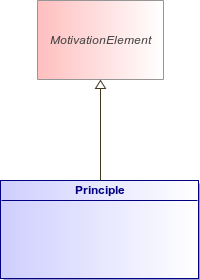
ArchiMate Metamodel
Principles are strongly related to goals and requirements. Similar to requirements, principles define intended properties of systems. However, in contrast to requirements, principles are broader in scope and more abstract than requirements. A principle defines a general property that applies to any system in a certain context. A requirement defines a property that applies to a specific system as described by an architecture.
A principle needs to be made specific for a given system by means of one or more requirements, in order to enforce that the system conforms to the principle. For example, the principle "Information management processes comply with all relevant laws, policies, and regulations" is realized by the requirements that are imposed by the actual laws, policies, and regulations that apply to the specific system under design.
A principle is motivated by some goal or driver. For example, the aforementioned principle may be motivated by the goal to maintain a good reputation and/or the goal to avoid penalties. The principle provides a means to realize its motivating goal, which is generally formulated as a guideline. This guideline constrains the design of all systems in a given context by stating the general properties that are required from any system in this context to realize the goal. Principles are intended to be more stable than requirements in the sense that they do not change as quickly as requirements may do. Organizational values, best practices, and design knowledge may be reflected and made applicable in terms of principles.
